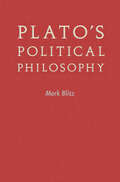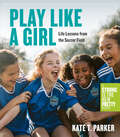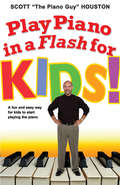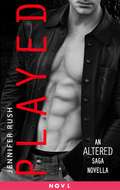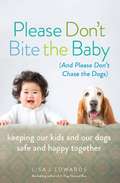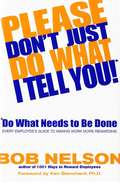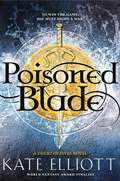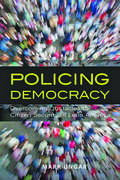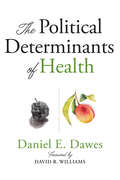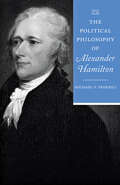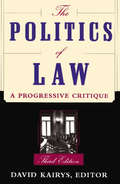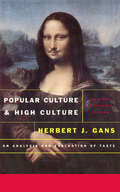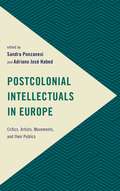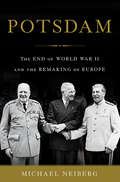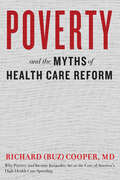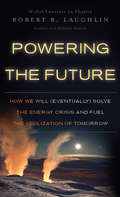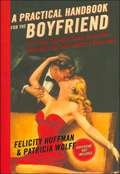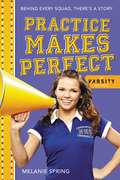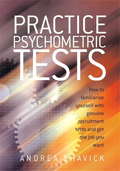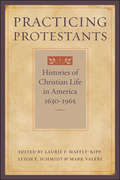- Table View
- List View
Plato's Political Philosophy
by Mark BlitzThis comprehensive, yet compact, introduction examines Plato's understanding of law, justice, virtue, and the connection between politics and philosophy.Focusing on three of Plato's dialogues—The Laws, The Republic, and The Statesman—Mark Blitz lays out the philosopher's principal interests in government and the strength and limit of the law, the connection between law and piety, the importance of founding, and the status and limits of political knowledge. He examines all of Plato's discussions of politics and virtues, comments on specific dialogues, and discusses the philosopher's explorations of beauty, pleasure, good, and the relations between politics and reason. Throughout, Blitz reinforces Plato's emphasis on clear and rigorous reasoning in ethics and political life and explains in straightforward language the valuable lessons one can draw from examining Plato's writings.The only introduction to Plato that both gathers his separate discussions of politically relevant topics and pays close attention to the context and structure of his dialogues, this volume directly contrasts the modern view of politics with that of the ancient master. It is an excellent companion to Plato's Dialogues.
Play Like a Girl: Life Lessons from the Soccer Field
by Kate T. ParkerA collection of black-and-white and color images of girls&’ and women soccer players, across a broad spectrum of age and skill from those just learning to kick a ball to the athletes who represented the United States on the 2019 World Cup championship team—from the New York Times bestselling author of The Heart of a Boy and Strong Is the New Pretty. Chapters are organized around life lessons derived from the game of soccer and include quotations from each of the subjects photographed.
Play Piano in a Flash for Kids!: A Fun and Easy Way for Kids to Start Playing the Piano
by Scott HoustonGetting a child to play piano has never been easier!As seen on public television nationwide, Scott "The Piano Guy" Houston is the leading authority on fast and fun piano instruction. In Play Piano in a Flash for Kids! he simplifies his unique and effective method of learning to play piano, making it accessible to even the youngest want-to-be pianists. Highlighting popular, not classical, music, this book fosters and nourishes an early love for music by giving children the tools to play their favorite popular songs.Your child will be able to: Learn the basics of piano playing using a simple technique that pros use, which focuses on becoming a good player versus becoming a good notation reader Use easy-to-follow step-by-step illustrations that demonstrate each stage of learning Play popular music on the piano without having to learn how to read complicated sheet musicIt is a great book for kids who may have taken lessons previously but became frustrated by the long and complicated process. And all at a fraction of the cost of piano lessons!Both parents and children can have fun learning the piano or keyboard together, or children can work through the book on their own, with parents providing support only when needed. Play Piano in a Flash for Kids! is the perfect tool for parents or teachers to help their kids learn to play the piano quickly and easily.
Play Piano in a Flash for Kids!: A Fun and Easy Way for Kids to Start Playing the Piano
by Scott HoustonGetting a child to play piano has never been easier!As seen on public television nationwide, Scott "The Piano Guy" Houston is the leading authority on fast and fun piano instruction. In Play Piano in a Flash for Kids! he simplifies his unique and effective method of learning to play piano, making it accessible to even the youngest want-to-be pianists. Highlighting popular, not classical, music, this book fosters and nourishes an early love for music by giving children the tools to play their favorite popular songs.Your child will be able to:Learn the basics of piano playing using a simple technique that pros use, which focuses on becoming a good player versus becoming a good notation reader Use easy-to-follow step-by-step illustrations that demonstrate each stage of learning Play popular music on the piano without having to learn how to read complicated sheet musicIt is a great book for kids who may have taken lessons previously but became frustrated by the long and complicated process. And all at a fraction of the cost of piano lessons!Both parents and children can have fun learning the piano or keyboard together, or children can work through the book on their own, with parents providing support only when needed. Play Piano in a Flash for Kids! is the perfect tool for parents or teachers to help their kids learn to play the piano quickly and easily.
Played: An Altered Saga Novella (Altered)
by Jennifer RushLeaving Nick and Elizabeth behind at the end of Reborn, genetically-altered Chloe has only one thing on her mind: revenge. She's determined to take the Branch down, starting with the organization's merciless leader Tom Riley.Tracking Riley to Washington, D.C., Chloe seems to be closing in on her goal with each passing hour. But just because the Branch made her virtually indestructible doesn't mean she's immune to her emotions. And when a shadow from her past appears in the unlikeliest of places, Chloe is forced to reexamine her allegiances once and for all. Another sexy and suspenseful novella in the Altered saga by Jennifer Rush.word count: 11,505 words.
Please Don't Bite the Baby (and Please Don't Chase the Dogs): Keeping Our Kids and Our Dogs Safe and Happy Together
by Lisa EdwardsPlease Don't Bite the Baby (and Please Don't Chase the Dogs) chronicles certified professional dog trainer Lisa Edwards’ endearing and entertaining journey to ensure that her household survives and thrives when she introduces her son to her motley pack of animals. As Lisa knows all too well, the dog/child relationship is simultaneously treasured, misunderstood, and sometimes feared. In a twist, Lisa's dog training techniques inevitably seep into how she navigates her first year with baby to mixed but enlightening results. Lisa includes her best training techniques for the everyday pet owner itemized at the end of each chapter. This book is important for parents, grandparents, and caregivers who have dogs and young children together and want to ensure safety for all.
Please Don't Just Do What I Tell You! Do What Needs to Be Done: Every Employee's Guide to Making Work More Rewarding
by Bob B. NelsonThe author of the million-copy-selling 1001 Ways series shows how to get ahead by fulfilling every employers ultimate expectation. This book contains a clear message: Every boss wants an effective worker to do what most needs to be done without having to be asked. Simple? Perhaps. Easy? Not on your life. But thanks to Bob Nelson, employers and employees everywhere will be empowered by this vital message, and in the process achieve their goals and create a mutually rewarding experience. As brief, to the point, and inspiring as his previous best-selling titles, Nelsons commonsense advice can be applied to any situation, from the mailroom to the boardroom, and is illustrated with a wide array of examples and anecdotes from real life. Helping readers tap into their own intelligence, resourcefulness, and pride, Nelson demonstrates how acts of initiative both big and small can make an enormous difference in the way an employee is viewed--and rewarded--by his or her boss; he also shows how the effects of those actions benefit the entire organization. It's a perfect first day on the job book; a useful resource for any HR department; and a worthwhile investment for anyone who wants to learn more and go farther in a job, in a career, and in life.
Poisoned Blade (Court of Fives #2)
by Kate ElliottIn this thrilling sequel to World Fantasy Award finalist Kate Elliott's bestselling young adult debut Court of Fives, a girl immersed in a high-stakes competition holds the fate of a kingdom in her hands.Jessamy is moving up the ranks of the Fives--the complex athletic contest favored by the lowliest Commoners and the loftiest Patrons in her embattled kingdom. Pitted against far more formidable adversaries, success is Jes's only option, as her prize money is essential to keeping her hidden family alive. She leaps at the change to tour the countryside and face more competitors, but then a fatal attack on her traveling party puts Jes at the center of the war that Lord Kalliarkos--the prince she still loves--is fighting against their country's enemies. With a sinister overlord watching her every move and Kal's life on the line, Jes must now become more than a Fives champion....She must become a warrior.
Policing Democracy: Overcoming Obstacles to Citizen Security in Latin America
by Mark UngarLatin America’s crime rates are astonishing by any standard—the region’s homicide rate is the world’s highest. This crisis continually traps governments between the need for comprehensive reform and the public demand for immediate action, usually meaning iron-fisted police tactics harking back to the repressive pre-1980s dictatorships. In Policing Democracy, Mark Ungar situates Latin America at a crossroads between its longstanding form of reactive policing and a problem-oriented approach based on prevention and citizen participation. Drawing on extensive case studies from Argentina, Bolivia, and Honduras, he reviews the full spectrum of areas needing reform: criminal law, policing, investigation, trial practices, and incarceration. Finally, Policing Democracy probes democratic politics, power relations, and regional disparities of security and reform to establish a framework for understanding the crisis and moving beyond it.
The Political Determinants of Health
by Daniel E. DawesReduced life expectancy, worsening health outcomes, health inequity, and declining health care options—these are now realities for most Americans. However, in a country of more than 325 million people, addressing everyone's issues is challenging. How can we effect beneficial change for everyone so we all can thrive? What is the great equalizer? In this book, Daniel E. Dawes argues that political determinants of health create the social drivers—including poor environmental conditions, inadequate transportation, unsafe neighborhoods, and lack of healthy food options—that affect all other dynamics of health. By understanding these determinants, their origins, and their impact on the equitable distribution of opportunities and resources, we will be better equipped to develop and implement actionable solutions to close the health gap.Dawes draws on his firsthand experience helping to shape major federal policies, including the Affordable Care Act, to describe the history of efforts to address the political determinants that have resulted in health inequities. Taking us further upstream to the underlying source of the causes of inequities, Dawes examines the political decisions that lead to our social conditions, makes the social determinants of health more accessible, and provides a playbook for how we can address them effectively. A thought-provoking and evocative account that considers both the policies we think of as "health policy" and those that we don't, The Political Determinants of Health provides a novel, multidisciplinary framework for addressing the systemic barriers preventing the United States from becoming the healthiest nation in the world.
The Political Philosophy of Alexander Hamilton (The Political Philosophy of the American Founders)
by Michael P. FedericiAmerica’s first treasury secretary and one of the three authors of the Federalist Papers, Alexander Hamilton stands as one of the nation’s important early statesmen. Michael P. Federici places this Founding Father among the country’s original political philosophers as well.Hamilton remains something of an enigma. Conservatives and liberals both claim him, and in his writings one can find material to support the positions of either camp. Taking a balanced and objective approach, Federici sorts through the written and historical record to reveal Hamilton’s philosophy as the synthetic product of a well-read and pragmatic figure whose intellectual genealogy drew on Classical thinkers such as Cicero and Plutarch, Christian theologians, and Enlightenment philosophers, including Hume and Montesquieu. In evaluating the thought of this republican and would-be empire builder, Federici explains that the apparent contradictions found in the Federalist Papers and other examples of Hamilton’s writings reflect both his practical engagement with debates over the French Revolution, capital expansion, commercialism, and other large issues of his time, and his search for a balance between central authority and federalism in the embryonic American government. This book challenges the view of Hamilton as a monarchist and shows him instead to be a strong advocate of American constitutionalism.Devoted to the whole of Hamilton’s political writing, this accessible and teachable analysis makes clear the enormous influence Hamilton had on the development of American political and economic institutions and policies.
The Political Philosophy of Alexander Hamilton (The Political Philosophy of the American Founders)
by Michael P. FedericiAmerica’s first treasury secretary and one of the three authors of the Federalist Papers, Alexander Hamilton stands as one of the nation’s important early statesmen. Michael P. Federici places this Founding Father among the country’s original political philosophers as well.Hamilton remains something of an enigma. Conservatives and liberals both claim him, and in his writings one can find material to support the positions of either camp. Taking a balanced and objective approach, Federici sorts through the written and historical record to reveal Hamilton’s philosophy as the synthetic product of a well-read and pragmatic figure whose intellectual genealogy drew on Classical thinkers such as Cicero and Plutarch, Christian theologians, and Enlightenment philosophers, including Hume and Montesquieu. In evaluating the thought of this republican and would-be empire builder, Federici explains that the apparent contradictions found in the Federalist Papers and other examples of Hamilton’s writings reflect both his practical engagement with debates over the French Revolution, capital expansion, commercialism, and other large issues of his time, and his search for a balance between central authority and federalism in the embryonic American government. This book challenges the view of Hamilton as a monarchist and shows him instead to be a strong advocate of American constitutionalism.Devoted to the whole of Hamilton’s political writing, this accessible and teachable analysis makes clear the enormous influence Hamilton had on the development of American political and economic institutions and policies.
The Politics Of Law: A Progressive Critique, Third Edition
by David KairysThe Politics of Law is the most widely read critique of the nature and role of the law in American society. This revised edition continues the book's concrete focus on the major subjects and fields of law. New essays on emerging fields and the latest trends and cases have been added to updated versions of the now-classic essays from earlier editions.A unique assortment of leading scholars and practitioners in law and related disciplines-political science, economics, sociology, criminology, history, and literature-raise basic questions about law, challenging long-held ideals like the separation of law from politics, economics, religion, and culture. They address such issues contextually and with a keen historical perspective as they explain and critique the law in a broad range of areas.This third edition contains essays on all of the subjects covered in the first year of law school while continuing the book's tradition of accessibility to non-law-trained readers. Insightful and powerful, The Politics of Law makes sense of the debates about judicial restraint and the range of legal controversies so central to American public life and culture.
Popular Culture and High Culture: An Analysis and Evaluation Of Taste
by Herbert GansIs NYPD Blue a less valid form of artistic expression than a Shakespearean drama? Who is to judge and by what standards?In this new edition of Herbert Gans's brilliantly conceived and clearly argued landmark work, he builds on his critique of the universality of high cultural standards. While conceding that popular and high culture have converged to some extent over the twenty-five years since he wrote the book, Gans holds that the choices of typical Ivy League graduates, not to mention Ph.D.'s in literature, are still very different from those of high school graduates, as are the movie houses, television channels, museums, and other cultural institutions they frequent.This new edition benefits greatly from Gans's discussion of the ”politicization” of culture over the last quarter-century. Popular Culture and High Culture is a must read for anyone interested in the vicissitudes of taste in American society.
Postcolonial Intellectuals in Europe: Academics, Artists, Activists and Their Publics (PDF) (Frontiers Of The Political: Doing International Politics Ser.)
by Sandra Ponzanesi Adriano José HabedPostcolonial intellectuals have engaged with and deeply impacted upon European society since the figure of the intellectual emerged at the beginning of the nineteenth century. Yet a critical assessment and overview of their influential roles is long overdue, particularly in the light of contemporary debates in Europe and beyond. This book offers an innovative take on the role of intellectuals in Europe through a postcolonial lens and, in doing so, questions the very definition of "public intellectual," on the one hand, and the meaning of such a thing as "Europe," on the other. It does so not only by offering portraits of charismatic figures such as Stuart Hall, Jacques Derrida, Antonio Gramsci, Frantz Fanon, and Hannah Arendt, among others, but also by exploring their lasting legacies and the many dialogues they have generated. The notion of the `classic' intellectual is further challenged by bringing to the fore artists, writers, and activists, as well as social movements, networks, and new forms of mobilization and collective engagement that are part of the intellectual scene.
Potsdam: The End of World War II and the Remaking of Europe
by Michael NeibergThe definitive account of the 1945 Potsdam Conference: the historic summit where Truman, Stalin, and Churchill met to determine the fate of post-World War II EuropeAfter Germany's defeat in World War II, Europe lay in tatters. Millions of refugees were dispersed across the continent. Food and fuel were scarce. Britain was bankrupt, while Germany had been reduced to rubble. In July of 1945, Harry Truman, Winston Churchill, and Joseph Stalin gathered in a quiet suburb of Berlin to negotiate a lasting peace: a peace that would finally put an end to the conflagration that had started in 1914, a peace under which Europe could be rebuilt.The award-winning historian Michael Neiberg brings the turbulent Potsdam conference to life, vividly capturing the delegates' personalities: Truman, trying to escape from the shadow of Franklin Roosevelt, who had died only months before; Churchill, bombastic and seemingly out of touch; Stalin, cunning and meticulous. For the first week, negotiations progressed relatively smoothly. But when the delegates took a recess for the British elections, Churchill was replaced-both as prime minster and as Britain's representative at the conference-in an unforeseen upset by Clement Attlee, a man Churchill disparagingly described as "a sheep in sheep's clothing." When the conference reconvened, the power dynamic had shifted dramatically, and the delegates struggled to find a new balance. Stalin took advantage of his strong position to demand control of Eastern Europe as recompense for the suffering experienced by the Soviet people and armies. The final resolutions of the Potsdam Conference, notably the division of Germany and the Soviet annexation of Poland, reflected the uneasy geopolitical equilibrium between East and West that would come to dominate the twentieth century.As Neiberg expertly shows, the delegates arrived at Potsdam determined to learn from the mistakes their predecessors made in the Treaty of Versailles. But, riven by tensions and dramatic debates over how to end the most recent war, they only dimly understood that their discussions of peace were giving birth to a new global conflict.
Potsdam: The End of World War II and the Remaking of Europe
by Michael NeibergThe definitive account of the 1945 Potsdam Conference: the historic summit where Truman, Stalin, and Churchill met to determine the fate of post-World War II Europe After Germany's defeat in World War II, Europe lay in tatters. Millions of refugees were dispersed across the continent. Food and fuel were scarce. Britain was bankrupt, while Germany had been reduced to rubble. In July of 1945, Harry Truman, Winston Churchill, and Joseph Stalin gathered in a quiet suburb of Berlin to negotiate a lasting peace: a peace that would finally put an end to the conflagration that had started in 1914, a peace under which Europe could be rebuilt. The award-winning historian Michael Neiberg brings the turbulent Potsdam conference to life, vividly capturing the delegates' personalities: Truman, trying to escape from the shadow of Franklin Roosevelt, who had died only months before; Churchill, bombastic and seemingly out of touch; Stalin, cunning and meticulous. For the first week, negotiations progressed relatively smoothly. But when the delegates took a recess for the British elections, Churchill was replaced-both as prime minster and as Britain's representative at the conference-in an unforeseen upset by Clement Attlee, a man Churchill disparagingly described as "a sheep in sheep's clothing." When the conference reconvened, the power dynamic had shifted dramatically, and the delegates struggled to find a new balance. Stalin took advantage of his strong position to demand control of Eastern Europe as recompense for the suffering experienced by the Soviet people and armies. The final resolutions of the Potsdam Conference, notably the division of Germany and the Soviet annexation of Poland, reflected the uneasy geopolitical equilibrium between East and West that would come to dominate the twentieth century. As Neiberg expertly shows, the delegates arrived at Potsdam determined to learn from the mistakes their predecessors made in the Treaty of Versailles. But, riven by tensions and dramatic debates over how to end the most recent war, they only dimly understood that their discussions of peace were giving birth to a new global conflict.
Poverty and the Myths of Health Care Reform
by Richard Buz CooperIn Poverty and the Myths of Health Care Reform, Dr. Richard (Buz) Cooper argues that US poverty and high health care spending are inextricably entwined. Our nation's health care system bears a financial burden that is greater than in any other developed country in large part because impoverished patients use more health care, driving up costs across the board.Drawing on decades of research, Dr. Cooper illuminates the geographic patterns of poverty, wealth, and health care utilization that exist across neighborhoods, regions, and states;¢;‚¬;€?and among countries. He chronicles the historical threads that have led to such differences, examines the approaches that have been taken to combat poverty throughout US history, and analyzes the impact that structural changes now envisioned for clinical practice are likely to have. His research reveals that ignoring the impact of low income on health care utilization while blaming rising costs on waste, inefficiency, and unnecessary care has led policy makers to reshape clinical practice in ways that impede providers who care for the poor.The first book to address the fundamental nexus that binds poverty and income inequality to soaring health care utilization and spending, Poverty and the Myths of Health Care Reform is a must-read for medical professionals, public health scholars, politicians, and anyone concerned with the heavy burden of inequality on the health of Americans.
Poverty and the Myths of Health Care Reform
by Richard Buz CooperIn Poverty and the Myths of Health Care Reform, Dr. Richard (Buz) Cooper argues that US poverty and high health care spending are inextricably entwined. Our nation's health care system bears a financial burden that is greater than in any other developed country in large part because impoverished patients use more health care, driving up costs across the board.Drawing on decades of research, Dr. Cooper illuminates the geographic patterns of poverty, wealth, and health care utilization that exist across neighborhoods, regions, and states;¢;‚¬;€?and among countries. He chronicles the historical threads that have led to such differences, examines the approaches that have been taken to combat poverty throughout US history, and analyzes the impact that structural changes now envisioned for clinical practice are likely to have. His research reveals that ignoring the impact of low income on health care utilization while blaming rising costs on waste, inefficiency, and unnecessary care has led policy makers to reshape clinical practice in ways that impede providers who care for the poor.The first book to address the fundamental nexus that binds poverty and income inequality to soaring health care utilization and spending, Poverty and the Myths of Health Care Reform is a must-read for medical professionals, public health scholars, politicians, and anyone concerned with the heavy burden of inequality on the health of Americans.
The Power of Selling
by Kim RichmondThe Power of Selling is the perfect textbook to teach students about the proven process of selling. More important, it teaches students how to apply the tenets of selling to how to sell themselves and get the job they want, with the same process professional sales people learn (or brush up) on their own selling skills. What makes someone successful in sales? Are great sales people born or made? Is there one magic selling process, or does the process change based on the business...or the customer? How can the selling process really come alive for students in the classroom? How do students learn how to sell for life, not just for a course? The Power of Selling by Kim Richmond answers these questions and makes the principles of selling come alive. Kim looks at the topic of selling through a different lens, and provides inspiration and ideas. The Power of Selling provides an exciting and interactive experience for both professors and students through the use of 4 unique elements: 1. Content The content is based on the core selling tenets so instructors will find the familiar principles of selling. In addition, the impact of Sales 2.0 is addressed at every stage including how to use interactive tools such as Twitter, LinkedIn, Facebook, blogs, and wikis effectively. 2. Selling U The last section of each chapter is called Selling U. It applies the concepts covered in the chapter to a student's job search. Selling U topics include how to think about yourself as a brand, how to create a powerful cover letter and resume, how to create your personal elevator pitch, how to use networking and informational interviews to get the word out about your brand, how to prepare and dress for an interview, and how to negotiate and accept the right job offer. What makes The Power of Selling different is that Selling U is integrated into every chapter, which makes this text the ultimate guide to selling yourself. 3. Video Resources Videos are used throughout the book. Additional videos that are not included in the text are available for instructor use. Here are videos that are available: * Video Ride-alongs - One of the best ways to learn about sales is by going on ride-alongs. So every chapter starts with an exclusive feature called a Video Ride-along. These short videos feature seven different sales professionals - one that starts each chapter. Each one talks about how he or she applies one of the key concepts covered in the chapter in their job. These videos are designed to be "virtual ride-alongs" so the students can actually feel as though they are getting insights first hand from selling professionals. * The Power of Selling YouTube Channel here (youtube.com/thepowerofselling) - Over 50 videos are included featuring the sales professionals who are highlighted in the Video Ride-alongs. About half of the videos are used in the textbook. The balance are available for instructor use. Several are included in Video Learning Segments (see below). These videos are excellent resources for use in the classroom, exercises, and assignments. * Video Learning Segments In addition to the traditional supplements of Instructor Manual, PowerPoints, and Test Bank, there are also Video Learning Segments. These are PowerPoint slides embedded with videos designed to supplement the course PowerPoints and focus on one concept, like an ethical dilemma, pre-call preparation, or effective presentations, how to use email effectively. Each segment includes slides, videos, discussion questions, or exercises. 4. The Power of Selling LinkedIn Group. here This group was created on LinkedIn.com expressly as a resource for the faculty and students who use this textbook. The group includes sales professionals from across the country and from different industries. This is a great tool for faculty and students alike to network, participate in discussions, ask questions, and connect with "real world" selling professionals.
Powering the Future: How We Will (Eventually) Solve the Energy Crisis and Fuel the Civilization of Tomorrow (Playaway Adult Nonfiction Ser.)
by Robert B. LaughlinIn Powering the Future, Nobel laureate Robert B. Laughlin transports us two centuries into the future, when we&’ve ceased to use carbon from the ground—either because humans have banned carbon burning or because fuel has simply run out. Boldly, Laughlin predicts no earth-shattering transformations will have taken place. Six generations from now, there will still be soccer moms, shopping malls, and business trips. Firesides will still be snug and warm.How will we do it? Not by discovering a magic bullet to slay our energy problems, but through a slew of fascinating technologies, drawing on wind, water, and fire. Powering the Future is an objective yet optimistic tour through alternative fuel sources, set in a world where we&’ve burned every last drop of petroleum and every last shovelful of coal. The Predictable: Fossil fuels will run out. The present flow of crude oil out of the ground equals in one day the average flow of the Mississippi River past New Orleans in thirteen minutes. If you add the energy equivalents of gas and coal, it&’s thirty-six minutes. At the present rate of consumption, we&’ll be out of fossil fuels in two centuries&’ time. We always choose the cheapest gas. From the nineteenth-century consolidation of the oil business to the California energy crisis of 2000-2001, the energy business has shown, time and again, how low prices dominate market share. Market forces—not green technology—will be the driver of energy innovation in the next 200 years. The laws of physics remain fixed. Energy will still be conserved, degrade entropically with use, and have to be disposed of as waste heat into outer space. How much energy a fuel can pack away in a given space is fixed by quantum mechanics—and if we want to keep flying jet planes, we will need carbon-based fuels. The Potential: Animal waste.If dried and burned, the world&’s agricultural manure would supply about one-third as much energy as all the coal we presently consume. Trash. The United States disposes of 88 million tons of carbon in its trash per year. While the incineration of waste trash is not enough to contribute meaningfully to the global demand for energy, it will constrain fuel prices by providing a cheap supply of carbon. Solar energy.The power used to light all the cities around the world is only one-millionth of the total power of sunlight pouring down on earth&’s daytime side. And the amount of hydropump storage required to store the world&’s daily electrical surge is equal to only eight times the volume of Lake Mead. PRAISE FOR ROBERT B. LAUGHLIN &“Perhaps the most brilliant theoretical physicist since Richard Feynman&”—George Chapline, Lawrence Livermore National Laboratory &“Powerful but controversial.&”— Financial Times &“[Laughlin&’s] company … is inspirational.&” —New Scientist
A Practical Handbook for the Boyfriend: For Every Guy Who Wants to Be One/For Every Girl Who Wants to Build One
by Felicity HuffmanMost dating books are written for women -- what a mistake that is. Women know how to date . . . It's men who need the help! At last: a blithe, bold, and bawdy guide to building a better boyfriend At some point, every guy -- player, geek, mama's boy, "regular Joe" -- meets a woman who makes him want to be a boyfriend. A good boyfriend. Problem is, unless he's had some first-rate training (by a previous girlfriend, a sister, a mom), he probably doesn't even know what that means. Felicity Huffman and Patricia Wolff come to the rescue with a rollicking -- and whip-smart -- handbook to navigating the minefield of male-female relationships. Directed at men (though of course it's women who'll buy it, then leave it at their boyfriend's place -- accidentally on purpose), A Practical Handbook for the Boyfriend lays out the many steps involved in becoming a good boyfriend, while still maintaining guy-dignity. It covers issues like: -Who decides when you become a boyfriend (answer: She does.) -How to look like you're listening, even when you're not (If you're busted, just say "You're so pretty, I'm distracted.") -Ten things never to say on the first date (#4: "I just did that to freak you out.") -Finding the middle ground between too cool (think third grade) and too eager (think surprise visits) -Why becoming a good boyfriend is a lot like training for the A team Filled with humor, ribaldry, common sense, and assorted outdoor skills, A Practical Handbook for the Boyfriend is the next dating guide to dominate the bestseller lists.
Practice Makes Perfect (A Varsity Novel #3)
by Melanie SpringBehind every squad, there's a story.It's spring semester at Northside High and the girls of the JV cheer squad are trying out for next fall. The pressure is on as Chloe, Devin, Kate, and Emily practice Varsity-level stunts amidst the drama of best friends, boyfriends, and frenemies. When jealousy and competition threaten to tear these besties apart, can the girls band together to dominate at tryouts?Book 3 in the Varsity series has more best-friend drama, boy trouble, and, of course, sideline spirit!
Practice Psychometric Tests: How to Familiarise Yourself with Genuine Recruitment Tests and Get the Job you Want (William Lorimer)
by Andrea ShavickFollowing the success of Andrea Shavick's Passing Psychometric Tests and Psychometric Tests for Graduates comes this book, crammed full of even more genuine practice psychometric tests from SHL Group plc, the biggest test publisher in the world. These are the tests used by over 95 per cent of the FTSE 100 companies to select their staff, as do the police, the Civil Service, local authorities, the Armed Forces, the Fire Service, financial institutions, retail companies, the communications industry, the motor industry, the IT industry, the power industry...the list is endless. So if you're looking for a job, you need this book! It includes:* 52 genuine practice tests from SHL Group plc, the biggest test publisher in the world. * 334 questions covering verbal, numerical, abstract and spatial reasoning, mechanical comprehension, fault diagnosis, accuracy and personality, including the popular OPQ 32 personality questionnaire.* Tips on how to improve your performance in every category of test. PLUS valuable advice about: * Online psychometric tests. * Whether or not it's possible to cheat!* How to improve your exam technique, speed up and concentrate. Above all this book will give you the three things you need to pass psychometric tests: information, confidence, and lots and lots of practice.
Practicing Protestants: Histories of Christian Life in America, 1630–1965 (Lived Religions)
by Laurie F. Maffly - Kipp Leigh E. Schmidt Mark ValeriThis collection of essays explores the significance of practice in understanding American Protestant life. The authors are historians of American religion, practical theologians, and pastors and were the twelve principal researchers in a three-year collaborative project sponsored by the Lilly Endowment. Profiling practices that range from Puritan devotional writing to twentieth-century prayer, from missionary tactics to African American ritual performance, these essays provide a unique historical perspective on how Protestants have lived their faith within and outside of the church and how practice has formed their identities and beliefs. Each chapter focuses on a different practice within a particular social and cultural context. The essays explore transformations in American religious culture from Puritan to Evangelical and Enlightenment sensibilities in New England, issues of mission, nationalism, and American empire in the nineteenth and twentieth centuries, devotional practices in the flux of modern intellectual predicaments, and the claims of late-twentieth-century liberal Protestant pluralism. Breaking new ground in ritual studies and cultural history, Practicing Protestants offers a distinctive history of American Protestant practice.
